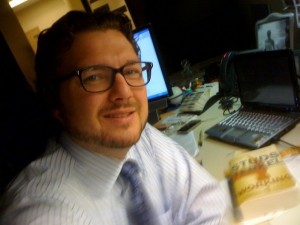Last week, I had the pleasure of attending the Texas Library Association Conference in San Antonio. While there, I had the opportunity to talk with Justin Hoenke (among many folks) who is also a contributor to this blog. We discussed his work at the Chattanooga Public Library and, specifically about the use of their 3D printer. Listening to him talk, it really struck me that at the basic level Justin does not really care about the 3D printer. The 3D printer is all well and good, but the thing that he is really after is the learning, the creativity, that the printer enables. Justin told me, “if libraries want to get into the maker movement, they don’t really need a 3D printer. They really just need a roll of duct tape and some raw materials to use in building” (this quote was given to me over drinks so please take it as more representative of his larger points as opposed to an exact quote). It was clear to me that Justin was not really a technologist, even if he uses technology to do his work. He gets excited about the things that people can do with the technology (even if the technology is a roll of duct tape).
This year my library received two awards for our campus-wide zombie game . We received the Proquest Innovation in Libraries Award from ACRL and the Innovation of the Year Award from our own campus. I mention these awards partly because of a character flaw where I like to show off. But I also bring these up because our library’s zombie game is comparable to Justin’s 3D printer. We didn’t organize our game because we wanted to play a game. We did it because we wanted to organize a learning event that enriched the curriculum in a unique way that no other campus department could. We could pull together IT support and student activities while still making the event curricular giving faculty a tool to use to create assignments. Faculty members from across the curriculum created assignments so that their students could participate. This included microbiology, nursing, statistics, massage therapy, criminal justice, writing, speech, and others.
It wasn’t too long ago when it was trendy for administrators within higher education to merge the library with IT departments. Obviously, every institution has their own reasons and goals when they reorganize, but this move always concerned me a little bit. I always have felt that moving libraries outside of the academic division sort of missed what libraries are all about. Moving libraries to IT emphasizes their role as learning infrastructure and DE-emphasizes their role in learning. And I have always thought that the whole point was learning. Perhaps, David Lankes makes the best point in The Atlas of New Librarianship. He notes that librarians can no longer think simply about service communities, but that librarians must focus on the learning needs of those service communities. It’s about curriculum.
So, what’s your curriculum? Your curriculum is simply the learning needs of community. Your curriculum ties together resources, events,  space, classes, technology, and other services aimed at learning. Your curriculum recasts the purpose of your library away from stuff, away from content. Your curriculum doesn’t just bring you face-to-face with your community. Your curriculum brings you face-to-face with your learners. And, most importantly, your curriculum is not about 3D printers or zombie games.
space, classes, technology, and other services aimed at learning. Your curriculum recasts the purpose of your library away from stuff, away from content. Your curriculum doesn’t just bring you face-to-face with your community. Your curriculum brings you face-to-face with your learners. And, most importantly, your curriculum is not about 3D printers or zombie games.
—————————————————————
Troy A. Swanson is Department Chair and Teaching & Learning Librarian at Moraine Valley Community College. He is the author of the book,Managing Social Media in Libraries. You can follow him on Twitter at @t_swanson.
